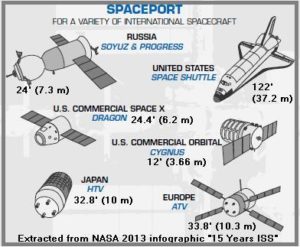
The above infographic (sizes added by Science15.com) does not visually represent the sizes of the vehicles. Although the vehicles may be of similar size, the Space Shuttle Orbiter (retired) was 122 feet in length, with the passenger bay being 40 feet in length, which is longer than the other depicted spaceships.
For an INFOGRAPHIC which better depicts the vehicle sizes and shows other vehicles, see the sidebar at this link.
Various international cargo ships servicing the International Space Station have seen failures.
In 2014, it was reported: SpaceX — which is headed by Musk — has made seven trips to the ISS under a contract the company has with NASA, the latest of which was completed on May 21 [2014]. It is the first company to complete a return trip to the space station, a feat previously achieved by only governments.
Dragon was also meant to bring back nearly 1,400 pounds of cargo, including hardware and trash, in its return trip. The spaceship was scheduled to land in the Pacific Ocean off the coast of Baja, California, in about five weeks.
The most recent resupply mission to fail occurred In late April when Russia[‘s Progress capsule ] had to abandon a trip to the International Space Station after its spacecraft carrying 3 tons of cargo lost control.
And last October, a cargo spacecraft developed by Orbital Sciences destined for the ISS exploded just after the company was awarded a $1.9 billion contract with NASA. (Orbital Sciences became known as Orbital ATK after merging with the aerospace arm of Alliant Techsystems in February.)
But those missions failed for different and unrelated reasons than the Dragon mission failed Sunday.
“There were no commonalities, just the fact that it’s space and it’s difficult to go fly,” said William Gerstenmaier, NASA’s associate administrator for human exploration.
Separately, one person died last fall — just days after the Orbital Sciences incident — when a craft developed by Virgin Galactic intended for eventual civilian passengers exploded during a flight over California.
Sunday’s launch from Cape Canaveral in Florida, in addition to resupplying the space station, was supposed to be the third attempt by SpaceX to recover the rocket that launches its spacecraft.
Typically, the expensive rockets that give spaceships their initial lift are discarded into the ocean after takeoff. In an attempt to recover and reuse those rockets, SpaceX developed a floating platform for the ejected rocket to land on.
SpaceX has made two previous attempts to land the first stage of its rocket — once in January and again in April. Both attempts at landing failed.
The ability to recover launch rockets is expected to move space travel further toward a future in which people, satellites and other items can be inexpensively launched into orbit.
Source: See the original article here.
To see information on the Progress, which is a cargo ship similar to the Soyuz crew ship and for which the capability has been recently developed to return to Earth with cargo, visit the next page.



